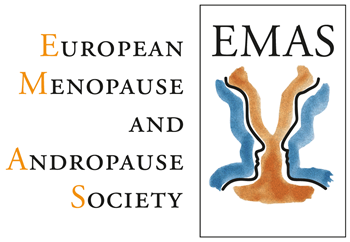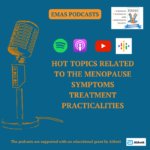Host: Welcome to today’s podcast. Long-term benefits of menopausal hormone therapy: A cardiovascular disease perspective. This episode is part of a podcast series supported by Abbott. The content is solely the responsibility of EMAS, the European Menopause and Andropause Society. All our episodes are available in English, Spanish, Mandarin, and Russian, and you can find them on any of the most popular podcast platforms.
In today’s episode, Dr. Elena Armeni, consultant endocrinologist at the Royal Free Hospital, London, United Kingdom will help us understand the changing cardiometabolic risk during the menopausal transition. The therapeutic approach according to the individual, cardiovascular needs, and the benefits of menopausal hormone therapy.
Dr. Elena Armeni: How do ageing and menopause affect the cardiovascular system? Following ovarian senescence, the production of estrogen decreases rapidly and levels of sex hormone-binding globulin also decrease due to the subsequent reduction in estrogen-liver interaction. This change results in an increase in circulating levels of sex hormones.
The rate of Androgen production declines, but to a lesser extent, given the ongoing contribution of the adrenal glands to the pool of circulating sex hormones. Consequently, the Androgen to estrogen ratio increases, resulting in an environment of relative androgenicity. This hormonal alteration, as well as ageing per se, and known to induce pathophysiological manifestations which consist of impaired fibrinolysis, insulin resistance, and visceral adiposity.
In this context, impaired fibrinolysis contributes to the origin and progression of atherosclerotic changes. Hyperandrogenism, but also visceral adiposity and insulin resistance, contribute to metabolic dysfunction, generation of oxidative stress, and low-grade inflammation. All of which have been linked with endothelial dysfunction. As described by experimental data, the early stages of the atherosclerotic process as well as hyperandrogenemia, have also been demonstrated to contribute to endothelial dysfunction which eventually results in more advanced atherosclerotic changes.
How can menopause hormone therapy help in terms of future cardiovascular risk? The effects of the treatment can be direct and indirect. The direct effect consists of estrogen and inflammatory and cardioprotective effects on the vessel walls and is most evident in cases where menopause hormone treatment is initiated before, or shortly after the onset of atherosclerosis. The timing hypothesis supports that menopause hormone treatment can ameliorate the progression of subclinical vascular disease provided it is administered to women earlier, rather than later after the menopausal transition and more specifically at an age less than 60 years, or within 10 years, since the final menstrual period.
The indirect effect of menopause hormone treatment consists of an improvement in the lipid profile, glucose homeostasis, and visceral adiposity. However, the evidence of the effect of menopausal hormone therapy on non-alcoholic fatty liver disease, and on blood pressure remains inconclusive.
So are there any safety data to consider when prescribing menopause hormone therapy? The prescription of a transdermal regimen is preferred over oral regimens. In fact, transdermal treatments do not increase the risk of venous thromboembolism and do not affect triglyceride concentrations. Extensive data supports that menopause hormone treatment can reduce the future risk of cardiovascular disease morbidity and mortality. In women with early menopause and, in particular, in women with premature ovarian insufficiency, treatment should be recommended at least until the average age of menopause, namely 50 to 52 years. In women who experienced menopause at an age of 50 to 52 years, menopause hormone treatment can reduce the future cardiovascular disease risk if commenced in the early postmenopausal period.
So is menopause hormone treatment the ultimate solution of the cardiovascular problems? Unfortunately, not, as pre-existing cardiovascular disease could affect the effectiveness of menopause hormone treatment with regard to future health. Therefore, the European Menopause and Andropause Society has recommended cardiovascular risk stratification, which should take place at the time of discussing treatment options.
For this purpose, the European score algorithm, or the American equivalent, ASCVD, scores can be used. Women with very high cardiovascular disease risk, estimated as equal or more than 10%, are eligible for topical vaginal estrogen treatment, which should be offered in combination with secondary prevention strategies targeting cardiovascular risk factors. Women with high risk estimated as a score risk of five up until less than 10% or, alternatively, the equivalent ASCVD score, can receive topical treatment. Primary or secondary prevention strategies are likely to be required for the control of cardiovascular risk factors.
If systemic treatment is needed, transdermal menopause hormone therapy can be offered on an individualized basis. Women with a moderate or low cardiovascular risk, less than 5%, can be offered any time of systemic treatment with or without primary prevention strategies for cardiovascular risk factors as needed. Thank you very much.
Host: Today, Dr. Elena Armeni discussed the pathophysiology of cardiometabolic risk at the time of the menopausal transition and the benefits of treatment with menopausal hormone therapy. Thank you for listening to today’s episode. We hope it will be valuable for your clinical and research practice. Stay safe.
[END]


